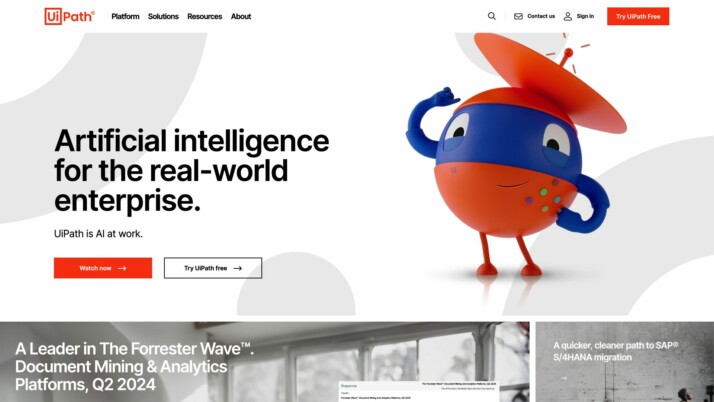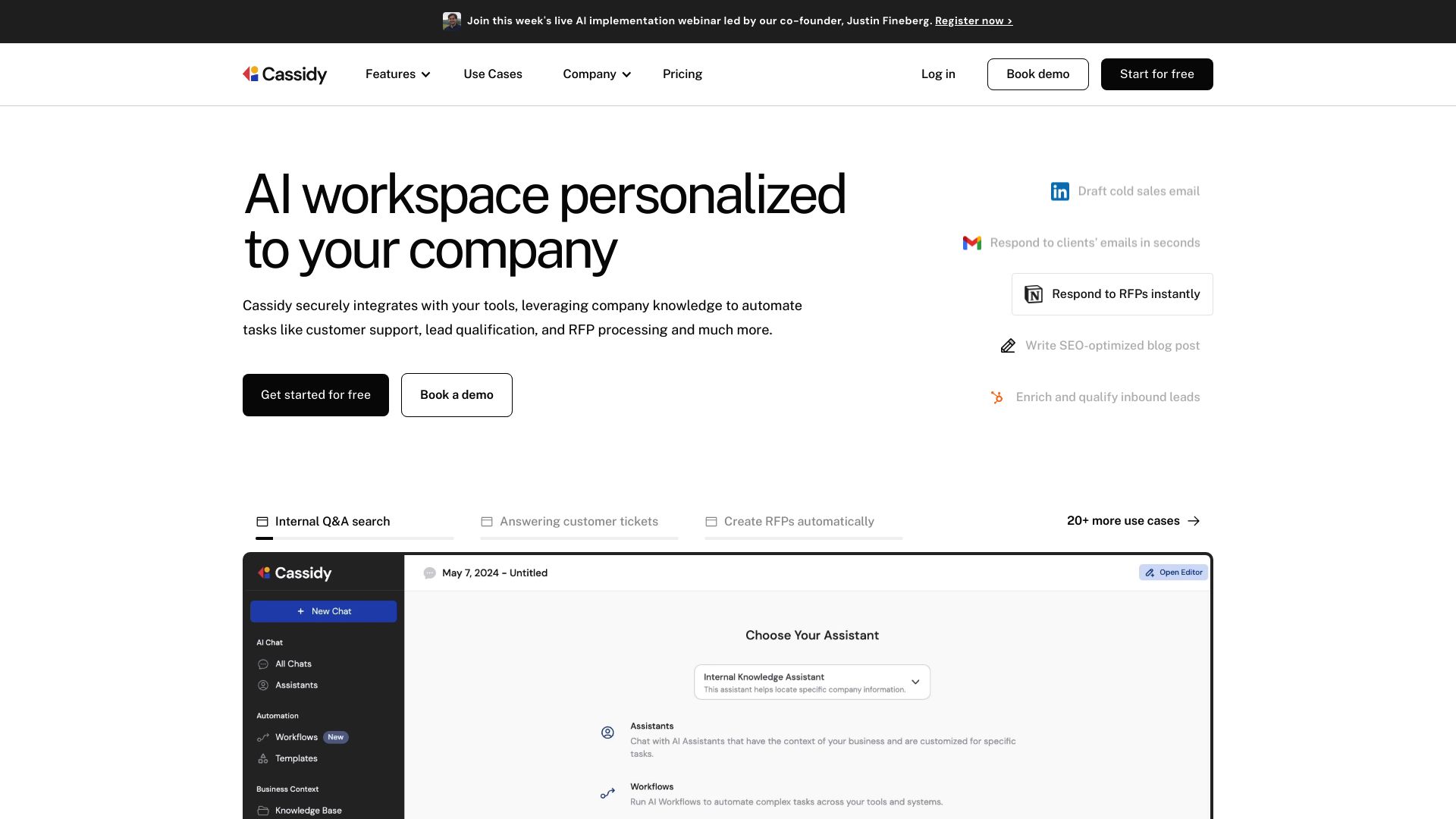UiPath vs. Cassidy: AI Automation Titans Compared
AI-powered automation platforms revolutionize business operations, enhancing efficiency and unlocking new productivity potential. This comparison delves into UiPath vs. Cassidy, and SmythOS, three leading solutions in the AI automation space. UiPath’s enterprise-grade robotic process automation, Cassidy’s customizable AI assistants, and SmythOS’s versatile AI development platform each offer unique approaches to streamlining workflows and integrating AI into business processes. We’ll examine their core features, integration capabilities, and user-friendliness to help you determine which platform best suits your organization’s needs. Whether you’re a developer seeking powerful API integrations, a business leader focused on scalability and security, or a non-technical professional looking for accessible AI tools, this analysis provides insights to guide your decision-making in adopting AI automation technology.
UiPath Overview
UiPath offers a comprehensive enterprise automation platform that empowers organizations to discover, build, manage, and measure automation across departments. The platform’s core product, UiPath Studio, provides a visual interface for creating robotic process automation (RPA) workflows, enabling both developers and business users to automate repetitive tasks efficiently.


UiPath’s strength lies in its ability to handle complex, enterprise-scale automation needs. The platform excels in process mining, allowing businesses to identify automation opportunities within their existing workflows. UiPath’s AI Center integrates artificial intelligence capabilities into automation processes, enhancing decision-making and data processing abilities.
UiPath offers a comprehensive enterprise automation platform that empowers organizations to discover, build, manage, and measure automation across departments.
UiPath distinguishes itself through robust orchestration features. The UiPath Orchestrator centralizes the management of automation robots, enabling scalable deployment across large organizations. This centralized control ensures consistent performance, security, and compliance across automated processes.
While UiPath offers powerful automation capabilities, its learning curve can be steep for non-technical users. The platform’s enterprise focus may also make it less suitable for smaller organizations or individual developers seeking simpler automation solutions. Additionally, while UiPath excels in structured workflow automation, it may not be the ideal choice for more open-ended, conversational AI applications.
UiPath integrates seamlessly with a wide range of enterprise systems and third-party applications, facilitating comprehensive automation solutions that span multiple departments and processes. The platform’s flexibility allows for both attended automation, where humans and robots collaborate, and unattended automation for back-office processes that run without direct supervision.
In the competitive landscape of automation platforms, UiPath positions itself as a leader in enterprise RPA. Its comprehensive feature set, scalability, and focus on AI integration make it a strong contender for large organizations looking to implement wide-reaching automation strategies. However, for smaller businesses or those seeking more specialized AI agent capabilities, other platforms may offer more tailored solutions.
Cassidy Overview
Cassidy specializes in creating customized AI automations and assistants for businesses. Their platform integrates securely with existing tools and leverages company knowledge to automate tasks like customer support, lead qualification, and RFP processing. This approach enhances productivity by equipping AI assistants and workflows with context specific to each business.


Cassidy’s platform stands out with its model-agnostic approach, allowing users to employ any foundational AI model. This flexibility future-proofs AI strategies and adapts to evolving business needs. The platform boasts seamless integration capabilities with various data sources, including Google Drive, Slack, and Notion, enabling businesses to leverage existing infrastructure.
Cassidy’s platform stands out with its model-agnostic approach, allowing users to employ any foundational AI model. This flexibility future-proofs AI strategies and adapts to evolving business needs.
Security remains a top priority for Cassidy, with enterprise-grade measures ensuring data confidentiality. The platform never uses client data for model training, maintaining strict privacy standards. For users seeking ease of use, Cassidy offers a no-code, drag-and-drop workflow builder. This intuitive interface empowers non-technical users to create complex AI automations without extensive coding knowledge.
Cassidy extends its AI capabilities beyond the platform with browser extensions. Their Chrome Extension brings AI functionalities directly into web applications like LinkedIn and email clients, enhancing productivity across various online tools. While Cassidy offers robust features for AI automation and integration, it lacks some advanced capabilities like autonomous agents and multimodal inputs, which may limit its applicability in certain complex scenarios.
Ultimately, Cassidy aims to improve AI adoption in businesses by making it accessible to non-technical users. Their vision centers on empowering all employees to harness AI for enhancing productivity and operational efficiency, regardless of technical background. By focusing on intuitive, customizable AI solutions that integrate seamlessly with existing business tools, Cassidy strives to transform how businesses operate in the AI-driven landscape.
Feature Comparison
UiPath and Cassidy offer distinct approaches to AI automation, with notable feature gaps between them. UiPath excels in robotic process automation (RPA) with its comprehensive enterprise-grade platform, while Cassidy focuses on customizable AI assistants and workflow automation.
In terms of core components, UiPath provides robust process mining capabilities and a centralized orchestration system, features absent in Cassidy’s offering. UiPath’s AI Center enables integration of AI models into automation workflows, a functionality not explicitly mentioned in Cassidy’s feature set. Cassidy, however, emphasizes its model-agnostic approach, allowing users to employ any foundational AI model, which provides greater flexibility compared to UiPath’s more structured AI integration.
Security-wise, both platforms prioritize data protection, but UiPath offers more granular control. UiPath provides IP whitelisting and OAuth support, features not explicitly mentioned for Cassidy. UiPath’s enterprise focus results in more comprehensive security measures, including detailed audit logs and governance tools, which may surpass Cassidy’s security offerings for large-scale deployments. Cassidy, while ensuring data confidentiality, does not specify the same level of enterprise-grade security features as UiPath.
Feature Comparison Table
| UiPath | Cassidy | SmythOS | |
|---|---|---|---|
| CORE FEATURES | |||
| AI Agents | ❌ | ✅ | ✅ |
| Hosted Agents (Dev, Production) | ❌ | ✅ | ✅ |
| No-Code Options | ❌ | ✅ | ✅ |
| Memory & Context | ❌ | ✅ | ✅ |
| Autonomous Agents | ❌ | ❌ | ✅ |
| Explainability & Transparency | ❌ | ❌ | ✅ |
| Multimodal | ❌ | ❌ | ✅ |
| Problem-Solving Capabilities | ❌ | ✅ | ✅ |
| Multi-Agent Collaboration | ❌ | ❌ | ✅ |
| Audit Logs for Analytics | ✅ | ❌ | ✅ |
| Work as Team | ❌ | ✅ | ✅ |
| SECURITY | |||
| Constrained Alignment | ❌ | ✅ | ✅ |
| IP Control | ✅ | ❌ | ✅ |
| COMPONENTS | |||
| Foundation AIs | ❌ | ✅ | ✅ |
| Huggingface AIs | ❌ | ❌ | ✅ |
| Zapier APIs | ❌ | ✅ | ✅ |
| Classifiers | ❌ | ❌ | ✅ |
| Data Lakes | ❌ | ❌ | ✅ |
| DEPLOYMENT OPTIONS (EMBODIMENTS) | |||
| Deploy as API | ❌ | ✅ | ✅ |
| Deploy as Webhook | ❌ | ✅ | ✅ |
| Staging Domains | ❌ | ❌ | ✅ |
| Production Domains | ❌ | ❌ | ✅ |
| API Authentication (OAuth + Key) | ✅ | ❌ | ✅ |
| Deploy as Site Chat | ❌ | ❌ | ✅ |
| Deploy as Scheduled Agent | ❌ | ✅ | ✅ |
| Deploy as GPT | ❌ | ❌ | ✅ |
| DATA LAKE SUPPORT | |||
| Hosted Vector Database | ❌ | ❌ | ✅ |
| Sitemap Crawler | ❌ | ❌ | ✅ |
| YouTube Transcript Crawler | ❌ | ❌ | ✅ |
| URL Crawler | ❌ | ❌ | ✅ |
| TXT File Support | ❌ | ✅ | ✅ |
Best Alternative to UiPath and Cassidy
SmythOS stands out as a superior alternative to UiPath and Cassidy, offering a comprehensive AI automation platform that combines ease of use with powerful features. Our drag-and-drop interface enables users to create complex AI workflows without extensive coding knowledge, democratizing AI development across organizations.
Unlike UiPath’s focus on robotic process automation or Cassidy’s emphasis on customizable AI assistants, SmythOS provides a versatile ecosystem for building and deploying AI agents. We support a wide range of AI models from providers like OpenAI, Anthropic, and Hugging Face, giving users unparalleled flexibility in their AI implementations.
SmythOS excels in multi-agent collaboration… Our platform enables teams of AI agents to work together on complex tasks, significantly enhancing the efficiency and scalability of AI solutions.
SmythOS excels in multi-agent collaboration, a feature absent in both UiPath and Cassidy. Our platform enables teams of AI agents to work together on complex tasks, significantly enhancing the efficiency and scalability of AI solutions. This capability, combined with our robust integration options, allows for seamless incorporation of AI into existing business processes.
Security and scalability set SmythOS apart from competitors. We offer enterprise-grade security features, including data encryption and OAuth support, addressing the stringent requirements of large-scale deployments. Our platform scales effortlessly to meet growing demands, ensuring that AI solutions remain effective as businesses expand.
SmythOS’s deployment options surpass those of UiPath and Cassidy. We support deployment as APIs, webhooks, site chats, and even as GPT models, providing unmatched versatility in how AI agents can be utilized. This flexibility, coupled with our extensive data lake support and hosted vector database, positions SmythOS as the ideal choice for organizations seeking a comprehensive, future-proof AI automation solution.
Conclusion
UiPath, Cassidy, and SmythOS each offer unique approaches to AI automation, catering to different business needs and technical expertise levels. UiPath excels in enterprise-grade robotic process automation with robust orchestration and security features. Cassidy focuses on customizable AI assistants and workflow automation with a user-friendly interface. SmythOS, however, emerges as the most versatile and powerful option, combining the strengths of both platforms while addressing their limitations.
SmythOS stands out with its comprehensive feature set, including hosted agents, visual building tools, and support for multimodal interactions. Its ability to deploy AI agents across various platforms, from APIs to chatbots, offers unparalleled flexibility. The platform’s emphasis on autonomous agents, problem-solving capabilities, and multi-agent collaboration pushes the boundaries of what’s possible in AI automation.
While UiPath and Cassidy may suit specific use cases, SmythOS’s ’Create Once, Deploy Anywhere’ philosophy and extensive integration ecosystem make it the superior choice for businesses seeking a future-proof AI solution. SmythOS democratizes AI development, making advanced capabilities accessible to both technical and non-technical users alike.
For those ready to explore the cutting edge of AI automation, we invite you to discover game-changing AI templates and create a free SmythOS account. Experience firsthand how SmythOS can revolutionize your workflow and unlock new possibilities in AI-driven productivity.
Last updated:
Disclaimer: The information presented in this article is for general informational purposes only and is provided as is. While we strive to keep the content up-to-date and accurate, we make no representations or warranties of any kind, express or implied, about the completeness, accuracy, reliability, suitability, or availability of the information contained in this article.
Any reliance you place on such information is strictly at your own risk. We reserve the right to make additions, deletions, or modifications to the contents of this article at any time without prior notice.
In no event will we be liable for any loss or damage including without limitation, indirect or consequential loss or damage, or any loss or damage whatsoever arising from loss of data, profits, or any other loss not specified herein arising out of, or in connection with, the use of this article.
Despite our best efforts, this article may contain oversights, errors, or omissions. If you notice any inaccuracies or have concerns about the content, please report them through our content feedback form. Your input helps us maintain the quality and reliability of our information.
